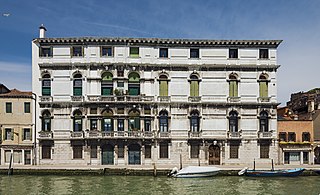
Ugo Foscolo, born Niccolò Foscolo, was a Greek-Italian writer, revolutionary and poet.

Arezzo is a city and comune in Italy and the capital of the province of the same name located in Tuscany. Arezzo is about 80 kilometres southeast of Florence at an elevation of 296 metres (971 ft) above sea level. As of 2022, the population was about 97,000.

Vincenzo Scamozzi was an Italian architect and a writer on architecture, active mainly in Vicenza and Republic of Venice area in the second half of the 16th century. He was perhaps the most important figure there between Andrea Palladio, whose unfinished projects he inherited at Palladio's death in 1580, and Baldassarre Longhena, Scamozzi's only pupil.

Andrea Palladio was an Italian Renaissance architect active in the Venetian Republic. Palladio, influenced by Roman and Greek architecture, primarily Vitruvius, is widely considered to be one of the most influential individuals in the history of architecture. While he designed churches and palaces, he was best known for country houses and villas. His teachings, summarized in the architectural treatise, The Four Books of Architecture, gained him wide recognition.

The Grand Canal is a channel in Venice, Italy. It forms one of the major water-traffic corridors in the city.

The Ca' d'Oro or Palazzo Santa Sofia is a palace on the Grand Canal in Venice, northern Italy. One of the older palaces in the city, its name means "golden house" due to the gilt and polychrome external decorations which once adorned its walls. Since 1927, it has been used as a museum, as the Galleria Giorgio Franchetti.

San Marco is one of the six sestieri of Venice, lying in the heart of the city as the main place of Venice. San Marco also includes the island of San Giorgio Maggiore. Although the district includes Saint Mark's Square, that was never administered as part of the sestiere.

The Palazzo della Cancelleria is a Renaissance palace in Rome, Italy, situated between the present Corso Vittorio Emanuele II and the Campo de' Fiori, in the rione of Parione. It was built 1489–1513 by Baccio Pontelli and Antonio da Sangallo the Elder as a palace for Raffaele Cardinal Riario, Camerlengo of the Holy Roman Church, and is regarded as the earliest Renaissance palace in Rome.

Zorzi (Giorgio) Alvise Baffo was an Italian poet and senator of the Venetian Republic.

Venetian Renaissance architecture began rather later than in Florence, not really before the 1480s, and throughout the period mostly relied on architects imported from elsewhere in Italy. The city was very rich during the period, and prone to fires, so there was a large amount of building going on most of the time, and at least the facades of Venetian buildings were often particularly luxuriantly ornamented.

Palazzo Corner della Ca' Granda, also called Ca' Corner della Ca' Granda or simply Palazzo Corner or Palazzo Cornaro, is a Renaissance-style palace located between the Casina delle Rose and the Rio di San Maurizio (Venice), across the Grand Canal from the Palazzo Venier dei Leoni, in the city of Venice, Italy. It is the current seat of the province of Venice and of the city's prefect.

The Palazzo Contarini delle Figure is a Renaissance-style palace located between the Palazzo Mocenigo Ca' Vecchia and Palazzo Erizzo Nani Mocenigo, across the Grand Canal from the Palazzo Civran Grimani in the sestiere di San Marco in the city of Venice, Italy.

Palazzo di Sangro, also known as either Palazzo de Sangro di Sansevero or Palazzo Sansevero, is a late-Renaissance-style aristocratic palace facing the church of San Domenico Maggiore, separated by the via named after the church, in the city center of Naples, Italy. Part of the palace facade faces the piazza in front of the church, which is also bordered to the south by the Palazzo di Sangro di Casacalenda.

Palazzo Contarini Dal Zaffo, also known as Palazzo Contarini Polignac is a large palace in Venice, located in the Dorsoduro district, overlooking the Grand Canal, in an intermediate position between Palazzo Brandolin Rota and Palazzo Balbi Valier.

Palazzo Nani is a Renaissance palace in the Cannaregio district of Venice, Italy.

Palazzo Civran Grimani is a Neoclassical palace in Venice, Italy. The palazzo is located in the San Polo district, overlooking the Grand Canal at the confluence with Rio della Frescada, between Palazzo Dandolo Paolucci and Palazzo Caotorta-Angaran.

Palazzo Soranzo Cappello is a palace in Venice, Italy located in the Santa Croce district, near Palazzo Gradenigo. The palace is currently occupied by the Superintendence of Archaeology, the Fine Arts and Landscape for the metropolitan area of Venice and the provinces of Belluno, Padua and Treviso.

Palazzo Malipiero-Trevisan is a Renaissance palace in Venice, Italy located in the Castello district, on the south-eastern side of campo Santa Maria Formosa and separated from it by the Santa Maria Formosa river.

Palazzo Surian Bellotto is a Baroque palace in Venice, Italy. The palazzo is located in the Cannaregio district and overlooks the Cannaregio Canal.

Palazzo Barbarigo Nani Mocenigo is a Gothic palace in Venice, Italy located in the Dorsoduro district, along the Nani embankment on the San Trovaso canal, near the Campo San Trovaso.


























